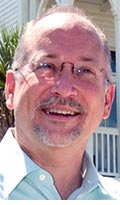Historic Preservation Symposium spotlights Texas heritage projects

Dwayne Jones
keynote speaker
[Early registration]
(https://secure.touchnet.com/C21490_ustores/web/store_main.jsp?STOREID=20)
ends February 15.
Preservation efforts at historic sites throughout Texas were highlighted at the Texas A&M [Center for Heritage Conservation] (http://chc.arch.tamu.edu) ’s annual [Historic Preservation Symposium] (http://chc.arch.tamu.edu/symposium-2013/) held March 1-2 at in downtown Bryan, Texas and the Langford Architecture Center on the Texas A&M campus.
Dwayne Jones, executive director of the [Galveston Historical Foundation] (http://www.galvestonhistory.org) , kicked off the discussion with a keynote address detailing the foundation’s efforts to preserve his city’s rich history, Friday, March 1 at the StageCenter Community Theatre in Bryan. His presentation was followed by a panel discussion moderated by David Woodcock, former CHC director and retired professor of architecture at Texas A&M.
The Galveston Historical Foundation, one of the U.S.’ largest nonprofit historic preservation organizations, has earned recognition from prominent state and national organizations for its many preservation efforts, including the redevelopment of [The Strand] (http://www.thestrand.com) , the rescue and restoration of [The Elissa] (http://www.galvestonhistory.org/1877_tall_ship_elissa.asp) , a three-masted, iron-hulled sailing ship built in 1877, the revitalization of historic residential neighborhoods, the creation of historic districts and the conception of signature events including [Dickens on The Strand] (http://www.galvestonhistory.org/Dickens_Overview.asp) and the Galveston Historic Homes Tour.

The American Institute of Architects presented a Citation of Honor to the foundation for its ongoing contribution to urban design and the quality of life in Galveston. In 2004, The Association for Preservation Technology International honored the foundation with a presidential citation.
Saturday, the symposium continued at the Texas A&M Langford Architecture Center, with a welcome and introductions by Robert Warden, director of the Center for Heritage Conservation. A series of presentations from historic preservationists representing several Texas universities followed.
Fran Gale, director of the University of Texas’ [Architectural Conservation Lab] (http://soa.utexas.edu/hp/conservation_lab/index.html) , presented updates on the lab's current projects. A research center serving academia, professionals and the public, the ACL is dedicated to understanding historic architectural materials through science. It holds an extensive collection of building material samples and supports the examination and testing of materials from historic buildings.
The morning presentation also highlighted efforts at UT’s graphic documentation and preservation studio, including a discussion about the [Austin Historical Survey Wiki] (http://beta.austinhistoricalsurvey.org/) , a living survey database allowing anyone to contribute information about Austin’s historic buildings, sites and landscapes of the past. Originally named Waterloo when it was founded in 1837, the city was renamed Austin in 1839 and designated the capital of the Republic of Texas.
Claire Cloudt, a Master of Architecture student at the University of Texas at San Antonio, presented her research on Brackettville, Texas’ [Montalvo House] (http://themontalvohouse.org/) , where Yldefonso and Guadalupe Montalvo raised nine children in a two-room caliche and cedar post home built in 1887.
An effort to restore and maintain the home, which has sported a Texas historic marker since 1979, is under way to “illustrate and teach how it was possible for our ancestors to achieve sustainable living in hopes that we may teach our current youth and community how to achieve equitable sustainability in the present,” states the home’s website.
Cloudt was followed with a presentation on the preservation efforts of the UTSA student preservation group, [Students Together Achieving Revitalization] (http://www.sanantonio.gov/historic/STAR.aspx) , by Sue Ann Pemberton, senior lecturer of architecture and historic preservation at UTSA.
Partnering with the city of San Antonio’s Office of Historic Preservation and local contractors, STAR students have repaired more than 25 historic residences since the effort began in the fall 2010 semester.
“Rethinking Urban Context, Materials and Structures from a Historic Perspective,” a presentation by UTSA’s Michael Braden, a Master of Architecture student, and Rachel Braden, a Master of Urban and Regional Planning student, followed.
Karina Perez, a research assistant at Texas A&M University-Kingsville, presented “Preserving History Using a Lens.”
She was followed by Anna Mod, a historic preservation consultant with [SWCA Environmental] (http://www.swca.com/) in Houston and an adjunct professor at Prairie View A&M University, who talked about her [book] (http://www.arcadiapublishing.com/9780738585246/Building-Modern-Houston) , “Building Modern Houston.”
Mod tells the story of Houston’s architecture during its transformation in the 1960s from “Bayou City” to “Space City,” when residents and tourists alike lined up to tour the revolutionary new Astrodome and the National Aeronautics and Space Administration built its new headquarters.
Texas Tech faculty members Elizabeth Louden, professor of architecture, and David Driskill, associate professor of architecture, made a presentation on downtown Lubbock revitalization projects.
Previous post
Tags
- arch gallery
- architecture
- archone gallery
- building a better texas
- coa gallery
- events
- feature
- heritage conservation
- history
- lectures
- outreach
- rss
Related Posts

Heritage symposium to focus on Alamo conservation efforts

Speakers to discuss preserving Texas sites at CHC confab

CHC study reveals decay on Alamo’s iconic west facade

CHC symposium to feature Houston preservation experts

CHC symposium to feature heritage of African-Americans
Follow Us
Facebook Twitter Vimeo Youtube Flickr RSS
Recent Posts

Planning prof heads study of disaster housing aid

A message from the dean

Former student remembered as expert planner

Leading educator named new head of Architecture Dept.









_thumbnail_small.png)
